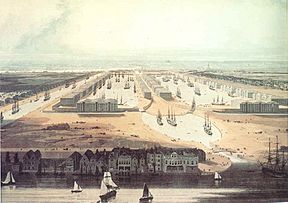City Canal facts for kids
Quick facts for kids City Canal |
|
|---|---|

An 1802 painting of the completed West India Docks. The City Canal is to the left of the painting. The view is looking west towards the City of London
|
|
| Specifications | |
| Locks | 2 |
| Status | incorporated into docks |
| History | |
| Date of act | 1799 |
| Date of first use | 1805 |
| Geography | |
| Start point | Isle of Dogs |
| Connects to | River Thames |
The City Canal was a short canal dug across the Isle of Dogs in east London. It connected two parts of the River Thames. Today, it has been almost completely rebuilt. It now forms the South Dock of the West India Docks.
Contents
History of the City Canal
Why the Canal Was Built
In 1799, a special law called the West India Docks Act was passed. This law allowed the City of London Corporation (the local government for the City of London) to build a canal. The canal would stretch from the Limehouse area to the Blackwall area, cutting across the Isle of Dogs.
The main idea was to create a shortcut for sailing ships. This would save them from having to travel all the way around the south of the Isle of Dogs. That longer journey was needed to reach the busy wharves (docks) further up the river. If the winds were not good, this trip could take a very long time.
Planning and Construction
An engineer named Ralph Walker first suggested the idea in 1796. He worked for the West India merchants. With help from William Jessop, John Foulds, and George Dance, they drew up detailed plans. These plans helped them get permission from Parliament to build the canal.
In August 1799, Jessop became the main engineer, and Walker was the engineer working on-site. However, Walker left in 1802 after a disagreement with Jessop. This happened after a part of the construction broke.
The canal was about 3,710 feet (1,130 meters) long. It was 173 feet (53 meters) wide at the surface and 45 feet (14 meters) deep. It had two locks, which are like water elevators for ships. Each lock was 193 feet (59 meters) long and 45 feet (14 meters) wide. The floors of the locks were built in the shape of upside-down arches. The lock walls were 6 feet (1.8 meters) thick and made of bricks with a stone covering.
At high tide, the water over the lock sills (the bottom of the lock gates) was between 20 and 24 feet (6 to 7.3 meters deep). This allowed ships weighing up to 500 tons to use the canal. The land around the canal had to be raised. Banks 12 feet (3.7 meters) high were built because the high tide was above the surrounding ground. The tops of these banks were 6 feet (1.8 meters) above the water level.
The canal was finished in 1805. It officially opened on December 9th of that year. Building the canal, including buying the land, cost about £168,813.
Challenges and Changes
Even though it was built, the City Canal was not very successful. Ships could only use it when the tide was right, and moving through it was slow. Also, the owners did not charge tolls (fees) for using it. Because of these problems, the canal did not make money.
In 1829, the canal became a problem for its owners. They sold it for £120,000 to the West India Dock Company. This company owned the docks right next to the canal. They bought it mainly to stop other dock companies from getting it. New docks opening nearby made them worried about competition.
Around 30 years later, from 1866 to 1870, the canal was made much bigger. Engineer Sir John Hawkshaw managed this project. The entrances were widened, and the whole area was renamed the South West India Dock. Later, it became known as the South Dock.
In 1926, a decision was made to connect the South Dock to the other West India docks and the Millwall Dock. This big project involved building a new entrance lock for the South Dock and three passages to link the different docks. These improvements were finished in 1931. They cost about £1,311,981 and made it much easier for ships to get into the docks.
The City Canal Today
Today, the South Dock is often used by medium-sized military ships visiting London. It is the furthest point up the river where these large ships can turn around. This is thanks to the rebuilding work done between 1926 and 1931. There is no longer a route for ships to cross the Isle of Dogs. Only the rebuilt eastern entrance remains.


